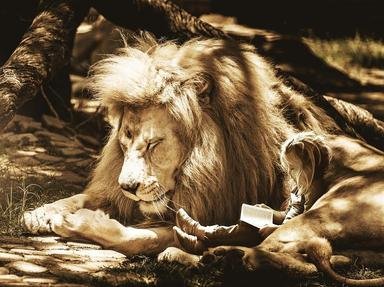Quiz Answer Key and Fun Facts
1. Which of the following would be quickly expelled from any fraternal organization whose founding members included the other three?
2. Of the four literary talking animals Stuart Little, Matthias, Reepicheep, and Tobermory, the odd beast out is a/an _ and the other three are all _.
3. In a room populated by the following, who would be the most clearly out of place?
4. Of the four literary talking animals Bree, Clover, Xanthos, and Zephir, the odd beast out is a/an _ and the other three are all _.
5. Which of the following has least in common with the other three?
6. Of the four literary language-using animals Cornelius, Reynard, Lord Russell, and The Tod, the odd beast out is a/an _ and the other three are all _.
7. Which of the following, probably feeling uncomfortable in the presence of the others, would likely be the quickest to take his or her leave at a chance meeting of the following four animals?
8. Of the four literary language-using animals Fenris, Isegrim, Keehar, and Raksha, the odd beast out is a/an _ and the other three are all _.
9. None of the following four characters belong to the same species, but three of them belong to the same family of closely related species. Which of them is the odd beast out?
10. Of the four literary language-using animals Baloo, Mudge, Trufflehunter, and John Wesley, the odd beast out is a/an _ and the other three are all members of the _ family.
11. Which of the following would be least welcome at a social gathering hosted by the other three?
12. Of the four literary language-using animals Hazel, Mopsy, Silvio, and Thorondor, the odd beast out is a/an _ and the other three are all _.
13. Which of the following would be in serious danger of being trodden upon by the other three, were all four to meet for drinks at the local pub?
14. Of the four literary language-using animals Babar, Hathi, Horton, and Tibert, the odd beast out is a/an _ and the other three are all _.
15. Which of the following has the least in common with the other three, physically speaking?
16. Of the four literary talking animals Billina, Hugi, Napoleon, and Polynesia the odd beast out is a/an _ and the other three are all _.
17. Which of the following characters is most likely to see the other three as his natural prey?
18. Of the four literary sentient animals Algernon, Behemoth, Cluny, and Ebenezer, what type of animal is the odd one out?
19. None of the following four characters belong to the same species, but three of them belong to the same taxonomical class. Which member of the phylum of arthropods is the odd beast out?
20. Of the four literary language-using arthropods Charlotte, Old Green, Scarce, and Tick-Tock, the odd bug out is a/an _ and the other three are all _.
21. Although all four of the following are quite different in appearance, which of them is a different species from the others?
22. OOf the four literary talking animals Bruin, Paddington, Mrs. Tiggy-Winkle, and Winnie, the odd beast out is a/an _ and the other three are all _.
23. One for the science fiction fans. On pure species grounds, which of the following would be hated and feared by the other three?
24. Of the four literary talking animals Barrister, Blu'ip, Creideiki, and Howard, the odd beast out is a/an _ and the other three are all _.
25. Final question. Who is the greatest talking animal of them all, the original lion king, the god of Narnia, the son of the Emperor-over-the-Sea: what is his name?
Source: Author
xaosdog
This quiz was reviewed by FunTrivia editor
agony before going online.
Any errors found in FunTrivia content are routinely corrected through our feedback system.
